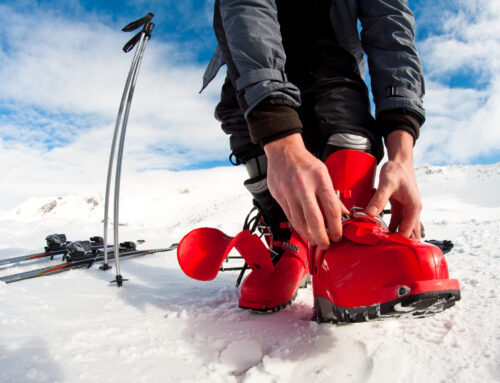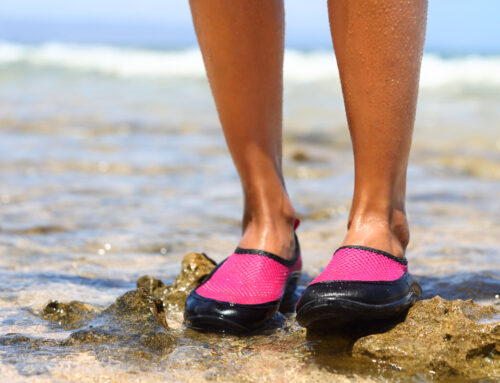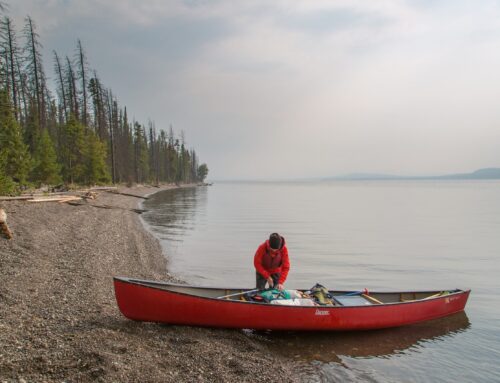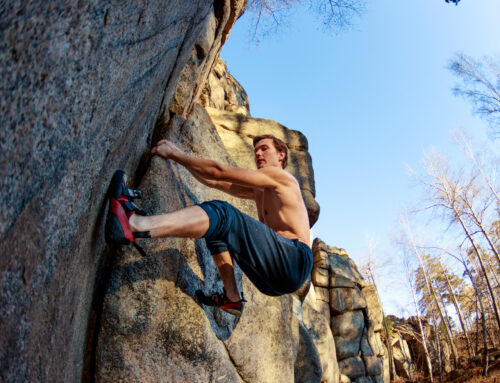Updated July 17, 2023
There are many different styles when it comes to camping. From classic tent camping, to RVing, campervan-ing, backpacking and wild/dispersed camping, there are so many different types of adventures you can choose from. Wild or dispersed camping is for those that like off-the-grid, self-sufficient types of adventures. It requires you to be well prepared, as you can’t easily go to a store if you forget some supplies. It’s easy to forget about the luxuries that you have at home and even some campgrounds until you no longer have them. To help you have a successful off-the-grid adventure, we’ve created this list of the best wild camping essentials so you can enjoy camping with no running water, no service, and no people.
Looking for a good camping spot? Check out these awesome campgrounds:
- 15 Fantastic Places to Go Camping Near Chicago
- 13 Serene Places to Go Camping Near Salt Lake City, Utah
- 13 Picturesque Places To Go Camping Near San Francisco
- 14 Awesome Places to Go Camping near Washington, DC
- 15 Scenic Places to Go Camping Near New York City
13 Wild Camping Essentials:
Lightweight Tent
Arguably one of the most important essentials for wild camping is a solid tent. If you’re backpacking, you’ll want a lightweight one or two person tent. If you’re driving off-road, you can opt for a heavier duty or bigger tent. Remember that this will be your shelter from the cold, wind and precipitation, so we’d recommend investing in one that will hold up.
The REI Quarter Dome is great because it has a sleek design, and it is easy to set up and use. It features a small vestibule area that is a practical feature for rain, wind and snow. You can also just use the fly and poles if you want an even more minimalistic style.
Sleeping Bag
A piece of camping gear that’s absolutely crucial, especially in the shoulder seasons, is a good sleeping bag. High altitude and mountain conditions can drop the temperatures below freezing even in the summer, so a warm sleeping bag is a must. There are a lot of different types of sleeping bags out there, but we suggest a mummy style bag. They’re warmer because they retain body heat and insulate better, and they take up less space in your backpack than a standard sleeping bag would.
You’ll want one that’s rated for at least 32 degrees fahrenheit, and if you’re planning on doing all-season or winter expeditions, you’ll want an even warmer one. You can always unzip the bag and use it as a blanket if it gets too hot. The Trailbreak 30 from REI is a great option, as it’s water resistant in damp conditions. It also has a three panel hood that keeps cold air from getting down into the bag, and the wider top section provides more comfort.
Sleeping Mat
While a good tent and sleeping bag will help you stay warm, a solid sleeping mat will keep you comfy. It can make all the difference between a restless and a good night’s sleep. The Exped MegaMat 10 is self-inflatable, making it easy to use, and the insulated feature helps keep you warm. Its R-value is 8.1, making it great for chillier weather and blocking the cold from the ground.
Hammock sleeping is also very popular, and some people say it beats sleeping on the ground any day. This is another great option if you’ll be camping in warmer weather.
Camp Stove
A camp stove is another wild camping essential you should bring, as it makes meals so much easier when you don’t have access to a store or kitchen. A good camp stove will let you cook your food quickly without much maintenance or issues. If you are cooking for multiple people, we recommend getting a classic two burner stove like the Coleman Cascade Classic Camp Stove. The double burner allows for better cooking with bigger meals, but it will be bulkier and harder to transport.
If you just need something simple, you can opt for a lighter-weight stove that does the basics of heating up food and water. A lightweight stove will be proficient in boiling water for dehydrated meals, ramen and hot beverages, but it will be more difficult to use a pot or pan on the burner. For this type of stove, we would recommend a Jetboil or a lightweight stove from MSR.
And don’t forget to bring the proper fuel, otherwise your camp stove will be useless!
Water Filter or Water Container
A water filter may not be necessary if you can bring enough water with you on your trip, but it’s a great thing to have just in case. The Guardian Gravity Purifier is a good choice for those who plan on staying in one area or campsite for a while. You just fill up the bag, hang it off the ground and let gravity pull the water through the filter, leaving you with clean drinking water. For those who are on the move every night and want a more portable option, we have and love the Grayl GEOPRESS Water Purifer. It’s easy to use and purifies water quickly.
If you don’t want to bring a water filter, then we’d recommend using a water container that you fill up at home. Experts say to have at least one gallon of water per person per day, so we would suggest a 5 gallon water container for shorter (2-5 days) trips.
Mess Kit & Cookware
A wild camping mess kit should be simple, but complete with all of the essentials. If it’s just you, then a fork, spoon, knife, bowl, plate and maybe a couple pieces of tupperware should suffice. If there’s two of you, we’d recommend doubling up on everything. The Sea to Summit Delta Camp Set has all of the basics you need for eating.
For cookware, it all depends on what you’ll be cooking. If it’s going to be mostly simple meals that mainly revolve around boiling water, you should be fine with a small pot and lid. Bring a pan along if you think you’ll be cooking some easy meals, like bacon and eggs.
More cookware options: tongs, spatula, strainer, kitchen knife, french press, cup, and/or a mug.
Knife, Machete or Hatchet
Along with a decent kitchen knife, you should bring a rugged instrument for cutting, chopping or whittling things. At the very least, bring a good buck knife, pocket knife or tactical knife that you can use for anything except preparing food.
If you’re planning on being self-sufficient and out in remote areas for a long time, we would also suggest a machete or hatchet. A machete is great for all kinds of things, from protection to landscaping sites. A hatchet is even more versatile and can come in handy for things you wouldn’t even think of. We love the Gerber Bushcraft Hatchet, which is a single piece hatchet with a lifetime warranty. It’s equipped with a waterproof stock storage stick where you can store an emergency chord, matches or fire starter.
Power Source
For those who are only backpacking, you might not need a powerful power source. But if you’re overlanding, driving to remote areas or road tripping for long periods of time, it’s definitely one of the most handy wild camping essentials.
Jackery makes great portable power boxes that are perfect for charging phones, laptops, lighting equipment and even coffee makers. They have a multitude of different styles to select from, but for easy use portable charging, we recommend the Jackery Explorer 1000 Pro. It fully solar charges in under 2 hours, has an 800 watt AC input and can be paired with all Jackery solar panels.
Lighting Source
To be safe, we would recommend bringing a couple different lighting sources when out camping in the wild, as each will serve a different purpose. The first kind of light you’ll want to bring is a high powered flashlight with a long battery life. This flashlight is an awesome option that offers both flood and spot settings.
We’d also suggest bringing a head lamp, as they are extremely practical when mulling around your site in the dark. We use the Black Diamond 400, which has a great battery life and powerful light.
The third type of lighting you’ll want to pack is a lantern to light up your site or tent. It’s not as essential as a flashlight, but it’s great to have as an extra or for emergencies. There’s a lot of LED battery powered lanterns on the market now so you don’t have to use a finicky old gas lantern.
Cooler
A cooler is not practical if you’re backpacking, but if you’re road tripping and camping in remote areas, it is a great item to have. It will allow you to keep ice, cold drinks and some foods that you otherwise wouldn’t be able to.
Cooler technology has changed rapidly in the past decade, and there are some really great coolers that will keep ice solid for days. Yeti is known for their stellar coolers, and they have an extensive collection of sizes, designs and materials that will surely match your camp style. The Yeti Roadie 24 Hard Cooler is one of the best options on the market. It was built with a taller profile to fit bigger items, but slim enough to fit in smaller spaces. It is marketed as “indestructible” and comes with a five year warranty.
Food
Food is something that will vary greatly from person to person, as we all have different diets. But some good camping staples that we’d recommend are:
- Coffee and/or tea
- Oatmeal
- Ramen
- Granola bars
- Rice cakes
- Peanut butter
- Bread
- Salt and pepper (could bring more spices if wanted)
- Canned tuna, sardines, anchovies
If you want more camp food options, be sure to check out Patagonia Provisions. They have a wide variety of meals you can choose from, so you won’t be stuck eating a PB & J sandwich for every meal.
First Aid Kit
While you hopefully won’t have to use it, it’s always best to pack for the worst case scenario so that you can be well prepared. It doesn’t have to be a super thorough kit, but make sure that it has the basics, like bandaids, gauze, tape, scissors, pain killers, butterfly closures and antibiotic and antiseptic ointment. The MyFAK Basic kit covers all of the essentials you’ll need for camping out in the wild.
Tell Someone Your Plans
When it comes to wild camping essentials, this is possibly the most important thing on the list. Every time you go out into the wilderness, whether it’s a short hike or a week-long backpacking trip, it is absolutely vital to tell someone where you’re going. Bad weather, injuries, and simply getting lost happens far too often. Even the most experienced woodsmen and guides can run into issues, and you’ll want someone to know where you are and how long you’re camping for, so they can look out for your safety. This may seem like a little thing, but it really could end up saving your life.
Other Wild Camping Gear:
While these items may be more luxurious than essential, we’d recommend bringing the following gear as well for a comfortable and safe camping trip:
- Chair
- Table
- Hotspot
- Day pack (see our complete guide to the best hiking day packs)
- Fire starter, matches, lighter
- Wet wipes
- Dr. Bronners soap (it’s good for anything)
- GPS

















